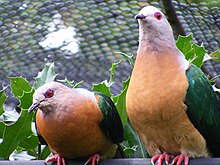Imperial pigeon
| Imperial pigeon | |
|---|---|
 |
|
| Purple-tailed imperial pigeon (Ducula rufigaster) | |
| Scientific classification | |
| Kingdom: | Animalia |
| Phylum: | Chordata |
| Class: | Aves |
| Order: | Columbiformes |
| Family: | Columbidae |
| Genus: |
Ducula Hodgson, 1836 |
Ducula is a major genus of the pigeon family Columbidae, collectively known as imperial pigeons. They are large to very large pigeons with a heavy build and medium to long tails. They are arboreal, feed mainly on fruit and are closely related to the other genus of fruit-eating doves, Ptilinopus. Both genera display brightly coloured plumage, predominantly green, often with contrasting under-parts of purple, orange or red. Some Ducula have prominently swollen ceres. They have large gapes and swallow seeds whole, playing an important role in seed dispersal.
Imperial pigeons are found in forests of southern Asia, New Guinea, northern Australia and the Pacific islands. Many species are nomadic, travelling long distances to exploit seasonal fruit sources. Some undertake migrations and all are strong fliers. Because of habitat loss and predation, species of Ducula are amongst the most threatened of avian species globally.
The taxonomy of the imperial pigeon is unresolved, with the number of species within the genus Ducula reported variably as 34 and 36. Derek Goodwin’s 1959 paper on the taxonomy of the genus Ducula divides his arrangement of 36 species into 7 subgroups according to distribution and phenotype. This classification is followed by Gibbs et al., and followed here.
Four species of imperial pigeon are found in Philippines and Sulawesi. All have a distinct pale band across the centre of the tail, and a rich green or purple dorsum. This grouping shares characteristics and distribution with Ptilinopus, and forms a link between the genera. The pink-belled (D. poliocephala) and the white-bellied (D. forsteni) imperial pigeon are similar and allopatric species. The Mindoro (D. mindorensis) and the grey-headed (D. radiata) imperial pigeons differ in size but are otherwise similar.
...
Wikipedia
